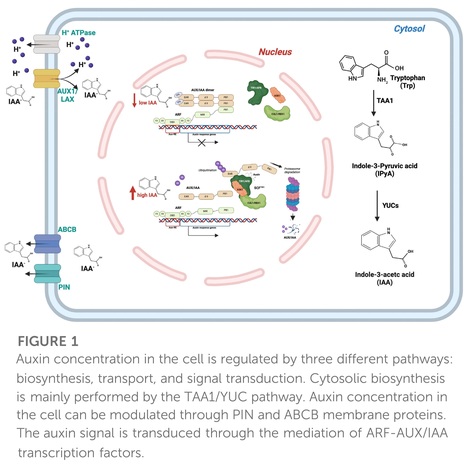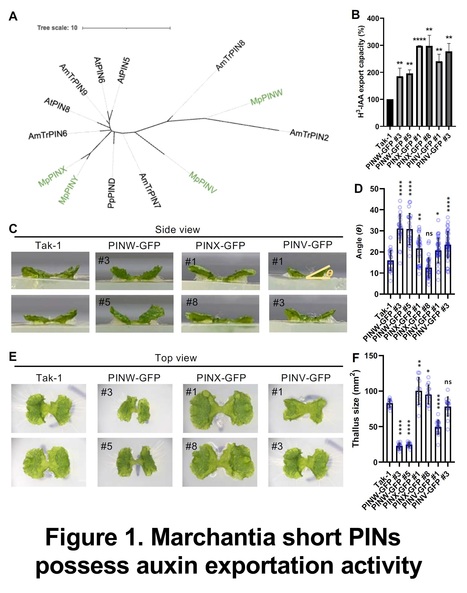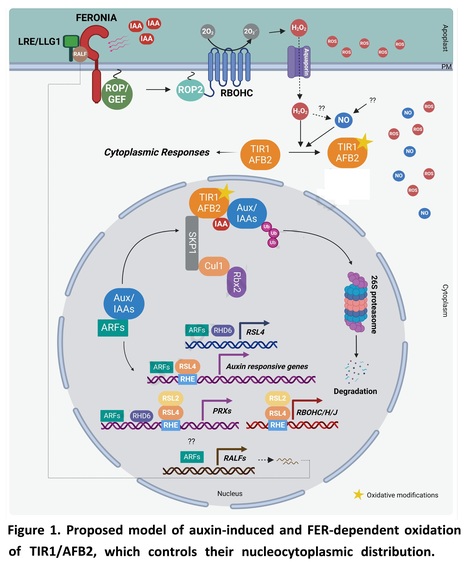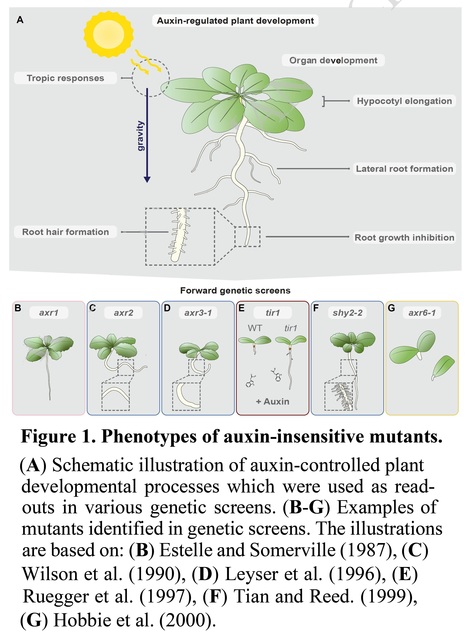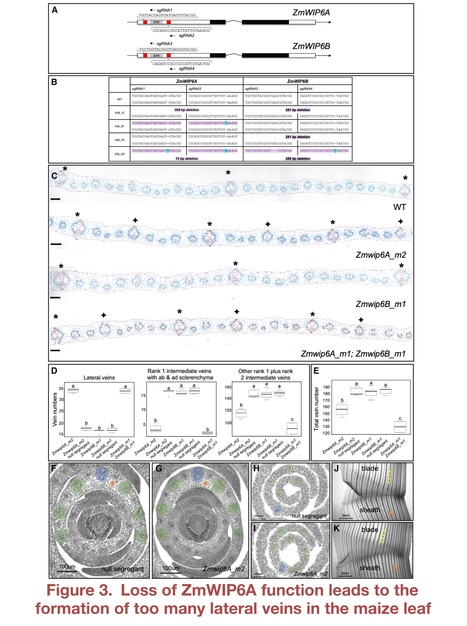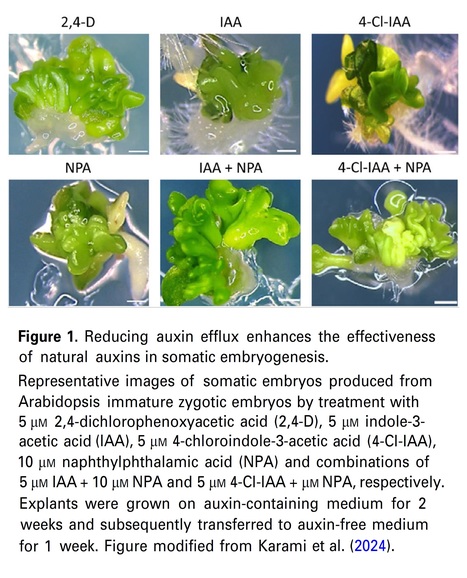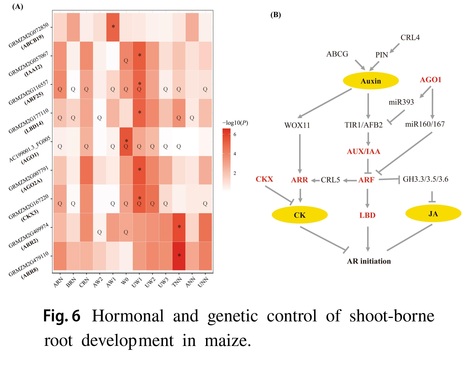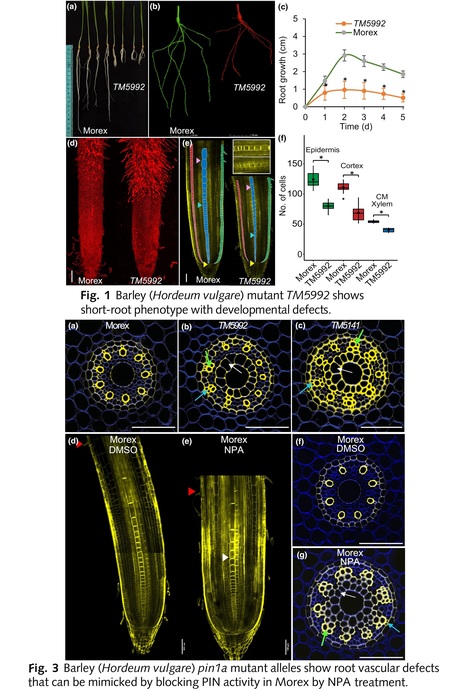 Your new post is loading...
 Your new post is loading...
Authors: Huixin Chen, Dongdong Li and Kunsong Chen.
Fruit Research (2024)
Abstract: "Strawberry, considered to be a model for non-climacteric fruits, has traditionally been viewed as having a less pronounced reliance on ethylene in fruit development. However, the inherent tissue heterogeneity within strawberry fruit, coupled with variable ethylene production levels, suggests a potential role for ethylene in the maturation of the true fruit, the achenes, dispersed on the fleshy receptacle. This intricate process is likely to exert ripple effects on the subsequent growth and ripening of the receptacle. To comprehensively unravel the functions of ethylene in strawberry fruit, there is a need for ethylene detection sensors, ethylene response reporter transgenic plants, and genetically engineered mutants achieved through genome editing, encompassing both biosynthesis and signaling mutants."
Authors: Jingyi Han (撖静宜), Thomas Welch, Ute Voß, Teva Vernoux, Rahul Bhosale and Anthony Bishopp.
iScience (2024)
Highlights • The first intron of ARF7 is required for expression in the root apical meristem. • It is not required for expression in either lateral roots or the shoot apex. • We find no binding sites in the first intron required for expression in root tips. • We propose that this intron exerts its effects via Intron Mediated Enhancement.
Abstract: "Auxin regulates plant growth and development through the transcription factors of the AUXIN RESPONSE FACTOR (ARF) gene family. ARF7 is one of five activators that bind DNA and elicit downstream transcriptional responses. In roots, ARF7 regulates growth, gravitropism and redundantly with ARF19, lateral root organogenesis. In this study we analyzed ARF7 cis-regulation, using different non-coding sequences of the ARF7 locus to drive GFP. We show that constructs containing the first intron led to increased signal in the root tip. Although bioinformatics analyses predicted several transcription factor binding sites in the first intron, we were unable to significantly alter expression of GFP in the root by mutating these. We instead observed the intronic sequences needed to be present within the transcribed sequences to drive expression in the root meristem. These data support a mechanism by which Intron Mediated Enhancement regulates the tissue specific expression of ARF7 in the root meristem."
Authors: Davide Marzi, Patrizia Brunetti, Shashank Sagar Saini, Gitanjali Yadav, Giuseppe Diego Puglia and Raffaele Dello Ioio.
Frontiers in Genetics (2024)
Abstract: "Global climate change (GCC) is posing a serious threat to organisms, particularly plants, which are sessile. Drought, salinity, and the accumulation of heavy metals alter soil composition and have detrimental effects on crops and wild plants. The hormone auxin plays a pivotal role in the response to stress conditions through the fine regulation of plant growth. Hence, rapid, tight, and coordinated regulation of its concentration is achieved by auxin modulation at multiple levels. Beyond the structural enzymes involved in auxin biosynthesis, transport, and signal transduction, transcription factors (TFs) can finely and rapidly drive auxin response in specific tissues. Auxin Response Factors (ARFs) such as the ARF4, 7, 8, 19 and many other TF families, such as WRKY and MADS, have been identified to play a role in modulating various auxin-mediated responses in recent times. Here, we review the most relevant and recent literature on TFs associated with the regulation of the biosynthetic, transport, and signalling auxin pathways and miRNA-related feedback loops in response to major abiotic stresses. Knowledge of the specific role of TFs may be of utmost importance in counteracting the effects of GCC on future agriculture and may pave the way for increased plant resilience."
Authors: Vojtěch Schmidt, Roman Skokan, Thomas Depaepe, Katarina Kurtović, Samuel Haluška, Stanislav Vosolsobě, Roberta Vaculíková, Anthony Pil, Petre Ivanov Dobrev, Václav Motyka, Dominique Van Der Straeten and Jan Petrášek.
Nature Communications (2024)
Editor's view: Here, the authors show that the biosynthesis of many compounds in green algae preceded their recruitment in phytohormone signaling and metabolism in land plants.
Abstract: "The genomes of charophyte green algae, close relatives of land plants, typically do not show signs of developmental regulation by phytohormones. However, scattered reports of endogenous phytohormone production in these organisms exist. We performed a comprehensive analysis of multiple phytohormones in Viridiplantae, focusing mainly on charophytes. We show that auxin, salicylic acid, ethylene and tRNA-derived cytokinins including cis-zeatin are found ubiquitously in Viridiplantae. By contrast, land plants but not green algae contain the trans-zeatin type cytokinins as well as auxin and cytokinin conjugates. Charophytes occasionally produce jasmonates and abscisic acid, whereas the latter is detected consistently in land plants. Several phytohormones are excreted into the culture medium, including auxin by charophytes and cytokinins and salicylic acid by Viridiplantae in general. We note that the conservation of phytohormone biosynthesis and signaling pathways known from angiosperms does not match the capacity for phytohormone biosynthesis in Viridiplantae. Our phylogenetically guided analysis of established algal cultures provides an important insight into phytohormone biosynthesis and metabolism across Streptophyta. Genomic evidence dates the origins of most phytohormones to terrestrialization or later."
Authors: Phanu T. Serivichyaswat, Abdul Kareem, Ming Feng and Charles W. Melnyk.
Plant Physiology (2024)
One-sentence summary: Auxin signaling in the cambial tissues promotes cell divisions and drives both tissue attachment and vascular differentiation during successful Arabidopsis grafting.
Abstract: "The strong ability of plants to regenerate wounds is exemplified by grafting when two plants are cut and joined together to grow as one. During graft healing, tissues attach, cells proliferate, and the vasculatures connect to form a graft union. The plant hormone auxin plays a central role, and auxin-related mutants perturb grafting success. Here, we investigated the role of individual cell types and their response to auxin during Arabidopsis (Arabidopsis thaliana) graft formation. By employing a cell-specific inducible misexpression system, we blocked auxin response in individual cell types using the bodenlos mutation. We found that auxin signaling in procambial tissues was critical for successful tissue attachment and vascular differentiation. In addition, we found that auxin signaling was required for cell divisions of the procambial cells during graft formation. Loss of function mutants in cambial pathways also perturbed attachment and phloem reconnection. We propose that cambial and procambial tissues drive tissue attachment and vascular differentiation during successful grafting. Our study thus refines our knowledge of graft development and furthers our understanding of the regenerative role of the cambium."
Authors: Hongjiao Jiang, Lijun Xie, Zhiqun Gu, Hongyao Mei, Haohao Wang, Jing Zhang, Minmin Wang, Yiteng Xu, Chuanen Zhou and Lu Han.
The Plant Journal (2024)
Significance Statement: Auxins play important roles in various aspects of plant growth and development. In Medicago truncatula, orthologs of PIN1-mediated auxin transportation are involved in various developmental processes and amino acid biosynthesis and metabolism in seeds, which offers insights into the molecular mechanisms governing seed size regulation in crops.
Abstract: "The regulation of seed development is critical for determining crop yield. Auxins are vital phytohormones that play roles in various aspects of plant growth and development. However, its role in amino acid biosynthesis and metabolism in seeds is not fully understood. In this study, we identified a mutant with small seeds through forward genetic screening in Medicago truncatula. The mutated gene encodes MtPIN4, an ortholog of PIN1. Using molecular approaches and integrative omics analyses, we discovered that auxin and amino acid content significantly decreased in mtpin4 seeds, highlighting the role of MtPIN4-mediated auxin distribution in amino acid biosynthesis and metabolism. Furthermore, genetic analysis revealed that the three orthologs of PIN1 have specific and overlapping functions in various developmental processes in M. truncatula. Our findings emphasize the significance of MtPIN4 in seed development and offer insights into the molecular mechanisms governing the regulation of seed size in crops. This knowledge could be applied to enhance crop quality by targeted manipulation of seed protein regulatory pathways."
Authors: Yoon Jeong Jang, Taehoon Kim, Makou Lin, Jeongim Kim, Kevin Begcy, Zhongchi Liu and Seonghee Lee.
bioRxiv (2024)
Abstract: "The plant hormone auxin plays a crucial role in regulating important functions in strawberry fruit development. Although a few studies have described the complex auxin biosynthetic and signaling pathway in wild diploid strawberry (Fragaria vesca), the molecular mechanisms underlying auxin biosynthesis and crosstalk in octoploid strawberry fruit development are not fully characterized. To address this knowledge gap, comprehensive transcriptomic analyses were conducted at different stages of fruit development and compared between the achene and receptacle to identify developmentally regulated auxin biosynthetic genes and transcription factors during the fruit ripening process. Similar to wild diploid strawberry, octoploid strawberry accumulates high levels of auxin in achene compared to receptacle. Consistently, genes functioning in auxin biosynthesis and conjugation, such as TRYPTOPHAN AMINOTRANSFERASE OF ARABIDOPSIS (TAAs), YUCCA (YUCs), and GRETCHEN HAGEN 3 (GH3s) were found to be primarily expressed in the achene, with low expression in the receptacle. Interestingly, several genes involved in auxin transport and signaling like PIN-FORMED (PINs), AUXIN/INDOLE-3-ACETIC ACID proteins (Aux/IAAs), TRANSPORT INHIBITOR RESPONSE 1 / AUXIN-SIGNALING F-BOX (TIR/AFBs) and AUXIN RESPONSE FACTOR (ARFs) were more abundantly expressed in the receptacle. Moreover, by examining DEGs and their transcriptional profiles across all six developmental stages, we identified key auxin-related genes co-clustered with transcription factors from the NAM-ATAF1,2-CUC2/ WRKYGQK motif (NAC/WYKY), BASIC REGION/ LEUCINE ZIPPER motif (bZIP), and APETALA2/Ethylene Responsive Factor (AP2/ERF) groups. These results elucidate the complex regulatory network of auxin biosynthesis and its intricate crosstalk within the achene and receptacle, enriching our understanding of fruit development in octoploid strawberries."
Authors: Han Tang, Adrijana Smoljan, Minxia Zou, Yuzhou Zhang, Kuan-Ju Lu and Jiří Friml.
bioRxiv (2024)
Abstract: "The plant hormone auxin and its directional transport are crucial for growth and development. PIN auxin transporters, on account of their polarized distribution, are instrumental in guiding auxin flow across tissues. Based on protein length and subcellular localization, the PIN family is classified into two groups: plasma membrane (PM)-localized long PINs and endoplasmic reticulum (ER)-localized short PINs. The origin of PINs was traced to the alga Klebsormidium, with a single PM-localized long KfPIN. Bryophytes, the earliest land plant clade, represent the initial clade harboring the short PINs. We tracked the evolutionary trajectory of the short PINs and explored their function and localization in the model bryophyte Marchantia polymorpha, which carries four short and one long PIN. Our findings reveal that all short MpPINs can export auxin, and they are all PM-localized with MpPINX and MpPINW exhibiting asymmetric distribution. We identified a unique miniW domain within the MpPINW hydrophilic loop region, which is sufficient for its PM localization. Phosphorylation site mutations within the miniW domain abolish the PM localization. These findings not only identify the essential sequence determinant of PINs' PM localization but also provide a unique insight into the evolution of ER-localized PINs. Short MpPINW, which is evolutionarily positioned between the ancestral long PINs and contemporary short PINs, still preserves the critical region essential for its PM localization. We propose that throughout land plant evolution, the unique miniW domain has been gradually lost thus converting the PM-localized short PINs in bryophytes to ER-localized short PINs in angiosperms."
Authors: Daoyun Chen, Yuqing Xu, Jiawei Li, Hiroshi Shiba, Hiroshi Ezura and Ning Wang.
International Journal of Molecular Sciences (2024)
Abstract: "Tomato (Solanum lycopersicum) breeding for improved fruit quality emphasizes selecting for desirable taste and characteristics, as well as enhancing disease resistance and yield. Seed germination is the initial step in the plant life cycle and directly affects crop productivity and yield. ERECTA (ER) is a receptor-like kinase (RLK) family protein known for its involvement in diverse developmental processes. We characterized a Micro-Tom EMS mutant designated as a knock-out mutant of sler. Our research reveals that SlER plays a central role in controlling critical traits such as inflorescence development, seed number, and seed germination. The elevation in auxin levels and alterations in the expression of ABSCISIC ACID INSENSITIVE 3 (ABI3) and ABI5 in sler seeds compared to the WT indicate that SlER modulates seed germination via auxin and abscisic acid (ABA) signaling. Additionally, we detected an increase in auxin content in the sler ovary and changes in the expression of auxin synthesis genes YUCCA flavin monooxygenases 1 (YUC1), YUC4, YUC5, and YUC6 as well as auxin response genes AUXIN RESPONSE FACTOR 5 (ARF5) and ARF7, suggesting that SlER regulates fruit development via auxin signaling."
Authors: Victoria Berdion Gabarain, Miguel A. Ibeas, Hernan Salinas-Grennet and José M. Estevez.
Molecular Plant (2024)
Excerpts: "A recent study published in Molecular Plant led by Prof. Chao Li (Lu et al. 2024) provides strong evidence that the targeting of TRANSPORT INHIBITOR RESPONSE 1 (TIR1)/AUXIN-SIGNALING F-BOX 2 (AFB2) to the nucleus is dependent on the oxidation triggered by auxin. The results of this work demonstrate that biologically active ROS, specifically hydrogen peroxide (H2O2) and nitric oxide (NO), play both a crucial role in the localization of TIR1/AFB2 proteins between the nucleus and cytoplasm in RHs (Figure 1)."
"The oxidized versions of TIR1 and AFB2 are essential for improving the effectiveness of TIR1 and AFB2 in transcriptional auxin responses in RH growth. Overall, a new mechanism is proposed by which auxin promotes the movement of TIR1/AFB2 from the cytoplasm to the nucleus and this process is controlled by the FER-ROS signaling pathway. The authors illuminate the complex interactions between auxin signaling pathways, redox signaling molecules, and protein changes that drive plant growth and development."
Authors: Martijn de Roij, Jan Willem Borst and Dolf Weijers.
The Plant Cell (2024)
One-sentence summary: The authors review the deeply intertwined roles of proteolytic regulation in the auxin response.
Abstract: "The signaling molecule auxin sits at the nexus of plant biology and coordinates essentially all growth and developmental processes in plants. Auxin molecules are transported throughout plant tissues and are capable of evoking highly specific physiological responses in plant cells by inducing various molecular pathways. In many of these pathways, proteolysis plays a crucial role for correct physiological responses. This review provides a chronology of the discovery and characterisation of the auxin receptor, which is a fascinating example of separate research trajectories ultimately converging on the discovery of a core auxin signaling hub which relies on degradation of a family of transcriptional inhibitor proteins – the Aux/IAAs. Beyond describing the “classical” proteolysis-driven auxin response system, we explore more recent examples of the interconnection of proteolytic systems, which target a range of other auxin signaling proteins, and auxin response. By highlighting these emerging concepts, we provide potential future directions to further investigate the role of protein degradation within the framework of auxin response."
Authors: Daniela Vlad, Maricris Zaidem, Chiara Perico, Olga Sedelnikova, Samik Bhattacharya and Jane A. Langdale.
Current Biology (2024)
Editor's view: Vlad et al. discover a conserved mechanism that determines whether procambial stem cells in grass leaf primordia will develop into large lateral or smaller intermediate veins. The mechanism is revealed through the analysis of mutants defective in the activity of a zinc finger transcription factor of the WIP6 family that is named TOO MANY LATERALS.
Highlights • Function of WIP6 ortholog TML is conserved in maize and rice • TML is expressed in procambial cells during early leaf vein development • tml mutants develop large lateral veins in places where smaller veins should form • TML function suppresses lateral vein development in a subset of procambial initials
Abstract: "Grass leaves are invariantly strap shaped with an elongated distal blade and a proximal sheath that wraps around the stem. Underpinning this shape is a scaffold of leaf veins, most of which extend in parallel along the proximo-distal leaf axis. Differences between species are apparent both in the vein types that develop and in the distance between veins across the medio-lateral leaf axis. A prominent engineering goal is to increase vein density in leaves of C3 photosynthesizing species to facilitate the introduction of the more efficient C4 pathway. Here, we discover that the WIP6 transcription factor TOO MANY LATERALS (TML) specifies vein rank in both maize (C4) and rice (C3). Loss-of-function tml mutations cause large lateral veins to develop in positions normally occupied by smaller intermediate veins, and TML transcript localization in wild-type leaves is consistent with a role in suppressing lateral vein development in procambial cells that form intermediate veins. Attempts to manipulate TML function in rice were unsuccessful because transgene expression was silenced, suggesting that precise TML expression is essential for shoot viability. This finding may reflect the need to prevent the inappropriate activation of downstream targets or, given that transcriptome analysis revealed altered cytokinin and auxin signaling profiles in maize tml mutants, the need to prevent local or general hormonal imbalances. Importantly, rice tml mutants display an increased occupancy of veins in the leaf, providing a step toward an anatomical chassis for C4 engineering. Collectively, a conserved mechanism of vein rank specification in grass leaves has been revealed.
Author: Martin Balcerowicz
The Plant Journal (2024)
Excerpts: " The synthetic auxin 2,4-dichlorophenoxyacetic acid (2,4-D) stands out as the most effective inducer of somatic embryogenesis, whereas other synthetic auxins like 1-naphthaleneacetic acid (1-NAA) and natural auxins such as indole-3-acetic acid (IAA) yield inferior results (Gaj, 2004). However, the underlying reasons for 2,4-D's superior efficacy have remained elusive."
"He observed that 2,4-D is perceived by the same canonical auxin signalling pathway that senses IAA, suggesting that the superior effectiveness of 2,4-D is not due to differences in perception or signalling (Karami et al., 2023). However, 2,4-D differs in its cellular availability, accumulating to higher levels within plant cells and exhibiting lower efficiency as a substrate for auxin efflux carriers than IAA (Delbarre et al., 1996; Seifertová et al., 2014). In the highlighted study, Karami and colleagues investigated whether these properties contribute to making 2,4-D a potent inducer of somatic embryogenesis."
"Given that 2,4-D is a poor substrate for auxin efflux, they examined the impact of the auxin efflux inhibitor naphthylphthalamic acid (NPA) on the efficacy of various synthetic and natural auxins to induce embryo formation. Strikingly, combined treatment with IAA and NPA was as effective in generating somatic embryos as treatment with 2,4-D (Figure 1). NPA also enhanced the efficacy of other natural and synthetic auxins, with highest embryo numbers observed for a combination of 4-chloroindole-3-acetic acid (4-Cl-IAA) and NPA. Monitoring the expression of a pDR5::GUS auxin reporter showed that combined treatment of IAA or synthetic auxins with NPA elicited a stronger auxin response than treatment with either compound alone. These observations demonstrate that many auxins can efficiently induce somatic embryogenesis when auxin efflux is inhibited, likely due to increased intracellular auxin levels."
|
Authors: Yang Yu, Haixia Yu, Jing Peng, Wang Jinsong Yao, Yi Peng Wang, Feng Li Zhang, Shi Rong Wang, Yajie Zhao, Xiang Yu Zhao, Xian Sheng Zhang and Ying Hua Su.
Plant Communications (2024)
Editor's view: TaLAX1 can promote shoot regeneration, thereby boosting genetic transformation and genome editing in wheat by activating TaGRFs and TaGIF1, cytokinin biosynthesis genes, and auxin-response genes. Homologs of TaLAX1 can also enhance the regeneration capacity of maize and soybean.
Abstract: "In the realm of genetically transformed crops, the process of plant regeneration holds utmost significance. However, the low regeneration efficiency of several wheat varieties currently restricts the use of genetic transformation for gene functional analysis and improved crop production. This research explores overexpression of TaLAX PANICLE1 (TaLAX1), which markedly enhances regeneration efficiency, thereby boosting genetic transformation and genome editing in wheat. Particularly noteworthy is the substantial increase in regeneration efficiency of common wheat varieties previously regarded as recalcitrant to genetic transformation. Our study shows that increased expression of TaGROWTH-REGULATING FACTOR (TaGRF) genes, alongside that of their co-factor, TaGRF-INTERACTING FACTOR 1 (TaGIF1), enhances cytokinin accumulation and auxin response, which may play pivotal roles in the improved regeneration and transformation of TaLAX1-overexpressing wheat plants. Overexpression of TaLAX1 homologs also significantly increases the regeneration efficiency of maize and soybean, suggesting that both monocot and dicot crops can benefit from this enhancement. Our findings shed light on a gene that enhances wheat genetic transformation and elucidate molecular mechanisms that potentially underlie wheat regeneration."
Author: Daniel J. Cosgrove.
Annual Review of Plant Cell and Development (2024)
Abstract: "Expansins comprise an ancient group of cell wall proteins ubiquitous in land plants and their algal ancestors. During cell growth, they facilitate passive yielding of the wall's cellulose networks to turgor-generated tensile stresses, without evidence of enzymatic activity. Expansins are also implicated in fruit softening and other developmental processes and in adaptive responses to environmental stresses and pathogens. The major expansin families in plants include α-expansins (EXPAs), which act on cellulose-cellulose junctions, and β-expansins, which can act on xylans. EXPAs mediate acid growth, which contributes to wall enlargement by auxin and other growth agents. The genomes of diverse microbes, including many plant pathogens, also encode expansins designated expansin-like X. Expansins are proposed to disrupt noncovalent bonding between laterally aligned polysaccharides (notably cellulose), facilitating wall loosening for a variety of biological roles."
Authors: Wei Liu, Yuyan Cheng and Ziqiang Zhu (2024)
Journal of Plant Growth Regulation (2024)
Abstract: "The role of auxin in plant root thermomorphogenesis is still under debate. Here, we showed that auxin is necessary for root elongation in either seedling roots or detached roots. Our study clarified the uncertainty in the field and shed new light on future research in plant response to high ambient temperature."
Authors: Kei Tsuzuki, Taiki Suzuki, Michio Kuruma, Kotaro Nishiyama, Ken-ichiro Hayashi, Shinya Hagihara and Yoshiya Seto.
bioRxiv (2024)
Abstract: "Root parasitic plants in the Orobancheceae, such as Striga and Orobanche, cause significant damage to crop production. The germination step of these root parasitic plants is induced by host-root-derived strigolactones (SLs). After germination, the radicles elongate toward the host and invade the host root. We have previously discovered that a simple amino acid, tryptophan (Trp), as well as its metabolite, the plant hormone indole-3-acetic acid (IAA), can inhibit radicle elongation of Orobanche minor. These results suggest that auxin plays a crucial role in the radicle elongation step in root parasitic plants. In this report, we used various auxin chemical probes to dissect the auxin function in the radicle growth of O. minor and Striga hermonthica. We found that synthetic auxins inhibited radicle elongation. In addition, auxin receptor antagonist, auxinole, rescued the inhibition of radicle growth by exogenous IAA. Moreover, a polar transport inhibitor of auxin, N-1-naphthylphthalamic acid (NPA), affected radicle tropism. We also proved that exogenously applied Trp is converted into IAA in O. minor seeds, and auxinole partly rescued this radicle elongation. Our data demonstrate a pivotal role of auxin in radicle growth. Thus, manipulation of auxin function in root parasitic plants should offer a useful approach to combat these parasites."
Author: Gwendolyn K. Kirschner.
The Plant Journal (2024)
Excerpts: "Udvardi and Sonali Roy, a former post-doctoral fellow with Udvardi at the Noble Research Institute and now an assistant professor at Tennessee State University, together with a team of experts on legume rhizobial symbiosis from Oklahoma, Cambridge and Shanghai, analysed the role of GLVs for nodule development and positioning in more detail (Roy et al., 2024)."
"Transcriptional reporter expression in transgenic hairy roots showed that the expression of the five GLVs overlapped at sites of nodule initiation (Figure 1b). Out of these, MtGLV6, MtGLV9 and MtGLV10 were induced by short-term nitrogen deprivation stress, suggesting a role in early stages of symbiosis, such as the dedifferentiation of cortical cells or the regulation of early nodulin genes."
"The nitrogen-induced GLV10 peptide could integrate the nitrogen signal from the soil to adaptation of the root architecture. GLV10p treatment also led to more microcolonies and infection thread initiations. The authors hypothesise that the increase in infection might be a compensation for the reduction in nodule number: The plant initiates more infection threads to make an optimal number of nodules and derive sufficient nitrogen."
Authors: Lei Liang and Xiangyang Hu.
Phyton (2024)
Abstract: "With the rapid development of modern molecular biology and bioinformatics, many studies have proved that transcription factors play an important role in regulating the growth and development of plants. SPATULA (SPT) belongs to the bHLH transcription family and participates in many processes of regulating plant growth and development. This review systemically summarizes the multiple roles of SPT in plant growth, development, and stress response, including seed germination, flowering, leaf size, carpel development, and root elongation, which is helpful for us to better understand the functions of SPT."
Authors: Sahana Basu, Monika, Surbhi Kumari and Gautam Kumar.
Plant Physiology and Biochemistry (2024)
Highlights: • IAA induces lateral root formation in rice under submergence • ROS and RNS cause lysigenous aerenchyma formation in root cortex of rice • Submergence decreases ABA level, causing GA-mediated escape response in rice shoot • Enhanced antioxidant levels dampen nitro-oxidative damage during de-submergence
Abstract: "Constant change in global climate has become the most important limiting factor to crop productivity. Asymmetrical precipitations are causing recurrent flood events around the world. Submergence is one of the most detrimental abiotic stresses for sustainable rice production in the rainfed ecosystems of Southeast Asia. Therefore, the development of submergence-tolerant rice is an essential requirement to encounter food security. Submergence tolerance in rice is governed by the major quantitative trait locus (QTL) designated as Submergence1 (Sub1) near the centromere of chromosome 9. The introduction of the Sub1 in high-yielding rice varieties producing near-isogenic lines (NILs) has shown extreme submergence tolerance. The present study aimed to understand the responses of rice genotype IR64 and its Sub1 NIL IR64 Sub1 following one week of complete submergence treatment. Submergence imposed severe nitro-oxidative stress in both the rice genotypes, consequently disrupting the cellular redox homeostasis. In this study, IR64 exhibited higher NADPH oxidase activity accompanied by increased reactive oxygen species, reactive nitrogen species, and malondialdehyde buildups and cell death under submergence. Higher accumulations of 1-Aminocyclopropane-1-carboxylic acid, gibberellic acid, and Indole-3-acetic acid were also observed in IR64 which accelerated the plant growth and root cortical aerenchyma development following submergence. In contrast, IR64 Sub1 had enhanced submergence tolerance associated with an improved antioxidant defense system with sustainable morpho-physiological activities and restricted root aerenchyma formation. The comprehensive analyses of the responses of rice genotypes with contrasting submergence tolerance may demonstrate the intricacies of rice under complete submergence and may potentially contribute to improving stress resilience by advancing our understanding of the mechanisms of submergence tolerance in rice."
Authors: Pengcheng Li, Zhihai Zhang, Gui Xiao, Zheng Zhao, Kunhui He, Xiaohong Yang, Qingchun Pan, Guohua Mi, Zhongtao Jia, Jianbing Yan, Fanjun Chen and Lixing Yuan.
Theoretical and Applied Genetics (2024)
Abstract: "Efficient nutrient and water acquisition from soils depends on the root system architecture (RSA). However, the genetic determinants underlying RSA in maize remain largely unexplored. In this study, we conducted a comprehensive genetic analysis for 14 shoot-borne root traits using 513 inbred lines and 800 individuals from four recombinant inbred line (RIL) populations at the mature stage across multiple field trails. Our analysis revealed substantial phenotypic variation for these 14 root traits, with a total of 389 and 344 QTLs identified through genome-wide association analysis (GWAS) and linkage analysis, respectively. These QTLs collectively explained 32.2–65.0% and 23.7–63.4% of the trait variation within each population. Several a priori candidate genes involved in auxin and cytokinin signaling pathways, such as IAA26, ARF2, LBD37 and CKX3, were found to co-localize with these loci. In addition, a total of 69 transcription factors (TFs) from 27 TF families (MYB, NAC, bZIP, bHLH and WRKY) were found for shoot-borne root traits. A total of 19 genes including PIN3, LBD15, IAA32, IAA38 and ARR12 and 19 GWAS signals were overlapped with selective sweeps. Further, significant additive effects were found for root traits, and pyramiding the favorable alleles could enhance maize root development. These findings could contribute to understand the genetic basis of root development and evolution, and provided an important genetic resource for the genetic improvement of root traits in maize."
Via Jean-Michel Ané
Authors: Juan He, Xiaoyi Li, Qin Yu, Lu Peng, Li Chen, Jiajia Liu, Jianmei Wang, Xufeng Li and Yi Yang.
Plant, Cell & Environment (2024)
Summary statement: The AGC VIII kinase D6 PROTEIN KINASE (D6PK) phosphorylates PIN-FORMED (PIN) auxin efflux carriers, which is essential for auxin transport in plant cells. This study uncovers a new mechanism for D6PK stability through Cytosolic ABA Receptor Kinases-mediated phosphorylation to regulate auxin-controlled Arabidopsis growth and development.
Abstract: "The polar auxin transport is required for proper plant growth and development. D6 PROTEIN KINASE (D6PK) is required for the phosphorylation of PIN-FORMED (PIN) auxin efflux carriers to regulate auxin transport, while the regulation of D6PK stabilization is still poorly understood. Here, we found that Cytosolic ABA Receptor Kinases (CARKs) redundantly interact with D6PK, and the interactions are dependent on CARKs' kinase activities. Similarly, CARK3 also could interact with paralogs of D6PK, including D6PKL1, D6PKL2, and D6PKL3. The genetic analysis shows that D6PK acts the downstream of CARKs to regulate Arabidopsis growth, including hypocotyl, leaf area, vein formation, and the length of silique. Loss-of-function of CARK3 in overexpressing GFP-D6PK plants leads to reduce the level of D6PK protein, thereby rescues plant growth. In addition, the cell-free degradation assays indicate that D6PK is degraded through 26 S proteasome pathway, while the phosphorylation by CARK3 represses this process in cells. In summary, D6PK stabilization by the CARK family is required for auxin-mediated plant growth and development."
Authors: Riccardo Fusi, Sara Giulia Milner, Serena Rosignoli, Riccardo Bovina, Cristovão De Jesus Vieira Teixeira, Haoyu Lou, Brian S. Atkinson, Aditi N. Borkar, Larry M. York, Dylan H. Jones, Craig J. Sturrock, Nils Stein, Martin Mascher, Roberto Tuberosa, Devin O'Connor, Malcolm J. Bennett, Anthony Bishopp, Silvio Salvi and Rahul Bhosale.
New Phytologist (2024)
Abstract: "Barley (Hordeum vulgare) is an important global cereal crop and a model in genetic studies. Despite advances in characterising barley genomic resources, few mutant studies have identified genes controlling root architecture and anatomy, which plays a critical role in capturing soil resources. Our phenotypic screening of a TILLING mutant collection identified line TM5992 exhibiting a short-root phenotype compared with wild-type (WT) Morex background. Outcrossing TM5992 with barley variety Proctor and subsequent SNP array-based bulk segregant analysis, fine mapped the mutation to a cM scale. Exome sequencing pinpointed a mutation in the candidate gene HvPIN1a, further confirming this by analysing independent mutant alleles. Detailed analysis of root growth and anatomy in Hvpin1a mutant alleles exhibited a slower growth rate, shorter apical meristem and striking vascular patterning defects compared to WT. Expression and mutant analyses of PIN1 members in the closely related cereal brachypodium (Brachypodium distachyon) revealed that BdPIN1a and BdPIN1b were redundantly expressed in root vascular tissues but only Bdpin1a mutant allele displayed root vascular defects similar to Hvpin1a. We conclude that barley PIN1 genes have sub-functionalised in cereals, compared to Arabidopsis (Arabidopsis thaliana), where PIN1a sequences control root vascular patterning."
Authors: Xiuzhen Kong, Suhang Yu, Yali Xiong, Xiaoyun Song, Lucia Nevescanin-Moreno, Xiaoqing Wei, Jinliang Rao, Hu Zhou, Malcolm J. Bennett, Bipin K. Pandey and Guoqiang Huang.
Current Biology (2024)
Editor's view: Kong et al. provide evidence for the anchorage functions of root hairs in root penetration, a process that is regulated by OsYUC8-mediated auxin biosynthesis and OsAUX1-mediated auxin transport when roots encounter a compacted barrier.
Highlights • Mechanical impedance induced the upregulation of auxin biosynthesis in root apex • Auxin transport from root tip to hair zone promoted root penetration via root hair • Mutants of OsYUC8 and OsAUX1 had trouble penetrating into the compacted layer • Increased root hair length provided greater anchorage force for root penetration
Abstract: "Compacted soil layers adversely affect rooting depth and access to deeper nutrient and water resources, thereby impacting climate resilience of crop production and global food security. Root hair plays well-known roles in facilitating water and nutrient acquisition. Here, we report that root hair also contributes to root penetration into compacted layers. We demonstrate that longer root hair, induced by elevated auxin response during a root compaction response, improves the ability of rice roots to penetrate harder layers. This compaction-induced auxin response in the root hair zone is dependent on the root apex-expressed auxin synthesis gene OsYUCCA8 (OsYUC8), which is induced by compaction stress. This auxin source for root hair elongation relies on the auxin influx carrier AUXIN RESISTANT 1 (OsAUX1), mobilizing this signal from the root apex to the root hair zone. Mutants disrupting OsYUC8 and OsAUX1 genes exhibit shorter root hairs and weaker penetration ability into harder layers compared with wild type (WT). Root-hair-specific mutants phenocopy these auxin-signaling mutants, as they also exhibit an attenuated root penetration ability. We conclude that compaction stress upregulates OsYUC8-mediated auxin biosynthesis in the root apex, which is subsequently mobilized to the root hair zone by OsAUX1, where auxin promotes root hair elongation, improving anchorage of root tips to their surrounding soil environment and aiding their penetration ability into harder layers."
Authors: Tingliang Xu, Xiaowen Zheng, Yi Yang, Shumin Yang, Xingwan Yi, Chao Yu, Le Luo, Jia Wang, Tangren Cheng, Qixiang Zhang and Huitang Pan.
Planta (2024)
Main conclusion: IAA cooperates with JA to inhibit SA and negatively regulates rose black spot disease resistance.
Abstract: "Black spot disease caused by the fungus Marssonina rosae is the most prevalent and severe ailment in rose cultivation, leading to the appearance of black spots on leaves and eventual leaf fall, significantly impacting the utilization of roses in gardens. Salicylic acid (SA) and jasmonic acid (JA) are pivotal hormones that collaborate with indole-3 acetic acid (IAA) in regulating plant defense responses; however, the detailed mechanisms underlying the induction of black spot disease resistance by IAA, JA, and SA remain unclear. In this study, transcript analysis was conducted on resistant (R13–54) and susceptible (R12–26) lines following M. rosae infection. In addition, the impact of exogenous interference with IAA on SA- and JA-mediated disease resistance was examined. The continuous accumulation of JA, in synergy with IAA, inhibited activation of the SA signaling pathway in the early infection stage, thereby negatively regulating the induction of effective resistance to black spot disease. IAA administration alleviated the inhibition of SA on JA to negatively regulate the resistance of susceptible strains by further enhancing the synthesis and accumulation of JA. However, IAA did not contribute to the negative regulation of black spot resistance when high levels of JA were inhibited. Virus-induced gene silencing of RcTIFY10A, an inhibitor of the JA signaling pathway, further suggested that IAA upregulation led to a decrease in disease resistance, a phenomenon not observed when the JA signal was inhibited. Collectively, these findings indicate that the IAA-mediated negative regulation of black spot disease resistance relies on activation of the JA signaling pathway."
|



 Your new post is loading...
Your new post is loading...



